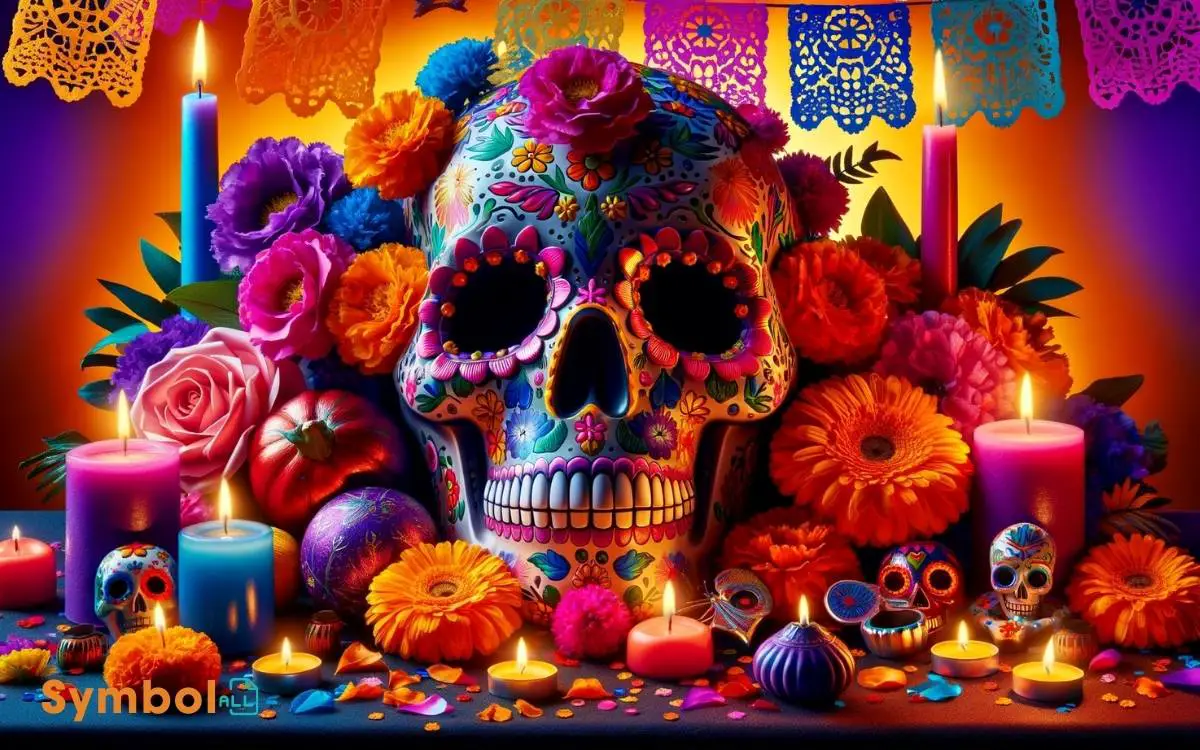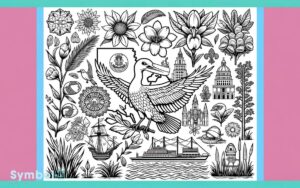Day of the Dead Colors and Symbols: Explained!
In the Day of the Dead, marigolds guide lost souls with their vibrant orange.
- White symbolizes purity, representing hope and spiritual rebirth.
- Red commemorates ancestors’ sacrifices, embodying love and life’s essence.
- Black doesn’t signal a conclusion but a continuum between life and death.
- Purple reflects mourning and collective sorrow, offering insight into the emotional depth of this day.
- Papel picado showcases life’s delicate nature, its designs bridging the worlds of the living and deceased.
Colors and symbols hold profound meanings, celebrating life while honoring those who’ve passed. Setting out on this exploration offers a deeper understanding of cultural reverence and connections beyond the visible.

Key Takeaway
Day of the Dead: Significance of Colors and Symbols
| Color/Symbol | Meaning/Significance |
|---|---|
| Orange | Represents the sun and unity; helps guide the souls to the altars |
| Purple | Symbolizes mourning, pain, and suffering; also a color of Catholic Lent |
| Pink | Celebratory color, representing happiness and hope |
| White | Symbolizes purity and hope; represents spirits of children (angelitos) |
| Yellow/Marigold | The color of death in Mexican culture; marigolds guide the spirits to altars |
| Red | Represents blood and life, also used to attract hummingbirds (souls of ancestors) |
| Blue | Associated with the Virgin Mary, connoting trust and faith |
| Sugar Skulls | Represents the departed soul, an offering to the spirits |
| Papel Picado | Cut paper banners, symbolizing the wind and the fragility of life |
| La Catrina | Iconic skeletal figure, representing a joyful afterlife and mockery of death |
| Candles | Light that guides the spirits to their altars and homes |
| Pan de Muerto | ‘Bread of the Dead,’ a traditional offering to honor the deceased |
The Significance of Marigolds
Marigolds, often referred to as the ‘flowers of the dead,’ play a pivotal role in Day of the Dead celebrations by symbolizing the fragility of life and guiding departed souls back to the living world.
You’ll find these vibrant orange and yellow blooms adorning altars and graves, their luminous colors and potent scent believed to attract spirits.
This practice, deeply rooted in Mexican culture, reflects a sophisticated understanding of life’s cyclical nature.
The marigold’s fleeting beauty, thriving in the fall and withering away soon after, mirrors the temporal existence of humans, emphasizing the importance of remembering and celebrating those who’ve passed.
White: Purity and Hope
You’ll find that white, symbolizing purity and hope in the Day of the Dead celebrations, carries a profound spiritual significance that bridges the world of the living and the deceased.
This color’s role varies greatly across cultures, offering a unique lens through which to view and understand the underlying beliefs and customs.
Spiritual Significance Explained
In the rich tapestry of Day of the Dead traditions, the color white symbolizes purity and hope, serving as a poignant reminder of spiritual renewal and peace for the souls of the departed.
This color’s significance is deeply rooted in spiritual beliefs and practices, offering a lens through which to understand the celebration’s underlying messages.
- Purity: White represents the unblemished state of the departed souls, signifying their purification and readiness to move on to the afterlife.
- Hope: It embodies the hope for spiritual rebirth and the belief in the cycle of life and death, suggesting a comforting continuity.
- Renewal: The color stands for the renewal of familial bonds, as families reunite in remembrance and celebration, transcending the spiritual domain.
Analyzing the spiritual significance of white within the Day of the Dead festivities reveals a complex interplay of cultural beliefs and practices, highlighting the celebration’s profound depth.
Cultural Interpretations Compared
Understanding the spiritual significance of white in the Day of the Dead celebration sets the stage for exploring how this color’s meanings of purity and hope compare across different cultures.
In Western traditions, white often symbolizes innocence and purity, frequently seen in wedding dresses and christening gowns.
You’ll notice a similar reverence for white in Eastern cultures, where it’s associated with mourning and remembrance, embodying both respect for the deceased and hope for the afterlife.
This duality of meaning underscores a universal appreciation for white’s symbolism, though the contexts vary greatly.
While in the Day of the Dead, white’s role is to welcome spirits back with purity and hope, in other cultures, it might signify a peaceful change or a clean slate, reflecting shared human values across diverse traditions.
Red: The Blood of Life
Red symbolizes the enduring vitality of life, flowing like the blood that courses through our veins, weaving a deep cultural significance into the tapestry of Day of the Dead celebrations.
This vibrant hue captures the essence of life’s continuous cycle, emphasizing the connection between the living and the deceased.
- Life’s Essence: Red represents the life force that binds the spiritual and physical worlds, highlighting the breath of life that animates us all.
- Sacrifice and Renewal: It commemorates the sacrifices made by those before us, acknowledging their role in nurturing and protecting the living.
- Love and Heart: Beyond vitality, red embodies the deep, abiding love for those who’ve passed, keeping their memory alive in the hearts of the living.
Through these elements, red serves as a poignant reminder of life’s fragility and the enduring bonds of love and sacrifice.
Black: The Land of the Dead
Shifting from the vibrant hues that celebrate life’s vitality, we now explore black, a color deeply rooted in the Day of the Dead‘s portrayal of the afterlife.
Black serves as a stark contrast to the festival’s brighter elements, symbolizing the land of the dead in a profound way.
It’s not just a color of mourning or loss, but a reminder of the mysterious world our loved ones move to.
In the tapestry of Day of the Dead celebrations, black accents in clothing, decorations, and altars don’t signify an end but a continuum.
They encapsulate the belief in an ongoing connection between the living and the dead, emphasizing that death isn’t a conclusion but a phase in a larger cycle of existence.
Through black, the Day of the Dead honors the unknown journey after life, inviting reflection and respect.
Purple: Pain and Suffering
In the rich palette of the Day of the Dead, purple stands as a poignant symbol of pain and suffering, encapsulating the deep emotional journey of grief.
This color doesn’t just explore; it communicates the universal experience of loss, offering a visual language that speaks to the heart of the observance.
Let’s investigate the significance of purple in this tradition:
- Representation of Mourning: It mirrors the traditional color worn during periods of mourning, signifying the community’s collective heartache.
- Spiritual Journey: Symbolizes the soul’s journey through suffering, reflecting on the transformative aspect of grief.
- Cultural Resonance: It ties deeply with indigenous beliefs where colors convey specific spiritual meanings, linking the material to the metaphysical world.
Understanding purple’s role offers insight into the cultural depth and emotional landscape of the Day of the Dead.
Sugar Skulls Explained
You’ll find that sugar skulls hold a fascinating place in the Day of the Dead celebrations, tracing back to ancient traditions.
These vibrant, meticulously decorated pieces aren’t just for show; they carry deep symbolic meanings, reflecting both respect for deceased loved ones and the whimsicality of life.
As we explore their origins and the layers of symbolism they encapsulate, you’ll gain a richer understanding of this cultural emblem.
Origins of Sugar Skulls
To comprehend the vibrant tradition of Day of the Dead, it’s important to explore the origins of sugar skulls, which are deeply rooted in both historical and cultural significance.
- Historical Roots: Sugar art was introduced to the New World by Italian missionaries in the 17th century. Over time, indigenous people of the Americas embraced this art form, using sugar skulls to honor deceased loved ones during Day of the Dead celebrations.
- Cultural Significance: These skulls symbolize a unique fusion of European Christian and indigenous Mexican beliefs, demonstrating how cultures can blend to create new traditions.
- Artistic Expression: Crafting sugar skulls requires careful attention to detail and color, reflecting the festive atmosphere of the festival and the joyful remembrance of those who’ve passed.
Understanding these origins enhances appreciation for the Day of the Dead’s rich cultural tapestry.
Symbolic Meanings Unveiled
Delving deeper into the tradition, sugar skulls carry a wealth of symbolic meanings that blend mortality and celebration in the Day of the Dead festivities.
These vibrant, often intricately decorated skulls aren’t just decorative; they’re rich in symbolism, reflecting a unique perspective on death’s place within life.
Each color, pattern, and design element holds significance, from commemorating the departed to expressing hope and joy amidst sorrow.
You’ll find names inscribed on the foreheads, personalizing each skull to honor specific loved ones who’ve passed away, thereby transforming an emblem of death into a message of remembrance and love.
This practice underscores the Day of the Dead’s core message: death isn’t an end but a continuum, woven seamlessly into the tapestry of life, celebrated with reverence, humor, and affection.
Papel Picado: Delicate Beauty
Capturing the ethereal essence of the Day of the Dead, papel picado embodies the delicate balance between artistry and cultural symbolism.
This traditional craft involves cutting elaborate designs into sheets of tissue paper, representing the fragility of life and the connection to the spiritual world.
Symbolism: Each design carries a deeper meaning, often related to the cyclical nature of life and death.
Technique: Artisans meticulously hand-cut or punch these intricate patterns, showcasing remarkable craftsmanship and attention to detail.
Cultural Significance: Used to decorate altars and streets, papel picado acts as a bridge between the living and the deceased, inviting spirits to partake in the celebrations.
Through papel picado, you’re invited to appreciate the beauty in life’s transience, acknowledging the artistry that intertwines with cultural heritage.
Conclusion
As you’ve journeyed through the vibrant tapestry of Day of the Dead, each color and symbol has whispered ancient tales. Marigolds bridge worlds, their fiery petals guiding spirits with golden light.
White, red, black, and purple hues dance together, painting a story of life, sacrifice, and remembrance. Sugar skulls grin amidst the festivities, while papel picado flutters like delicate wings of hope.
In this colorful mosaic, every thread weaves a deep connection to heritage, inviting you to reflect, honor, and celebrate the eternal cycle of life.






